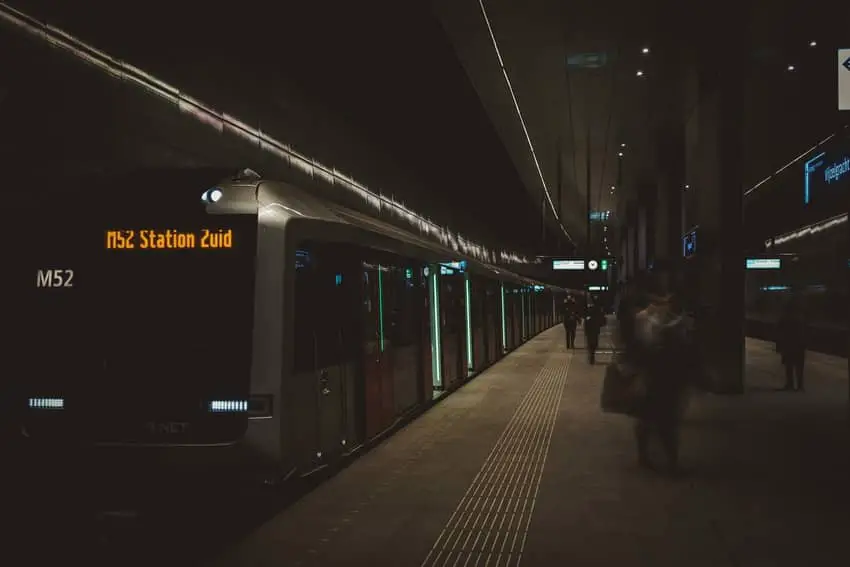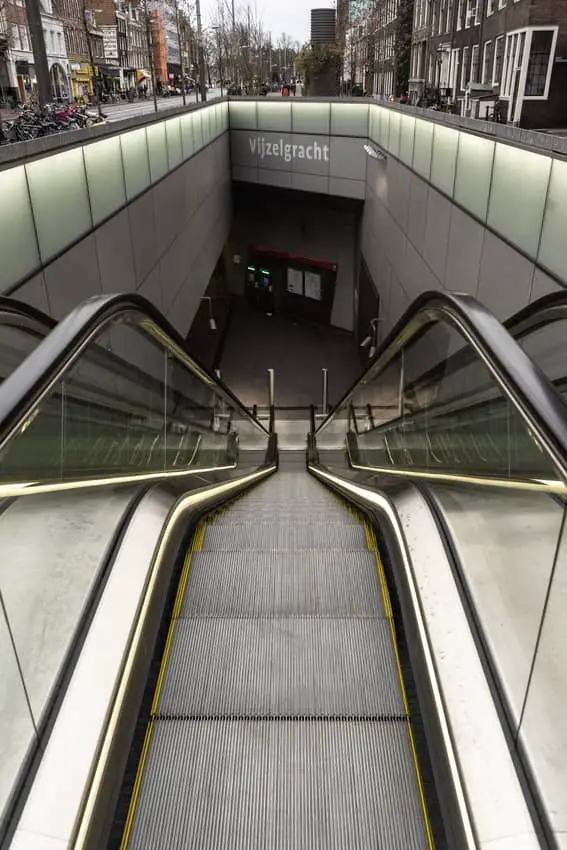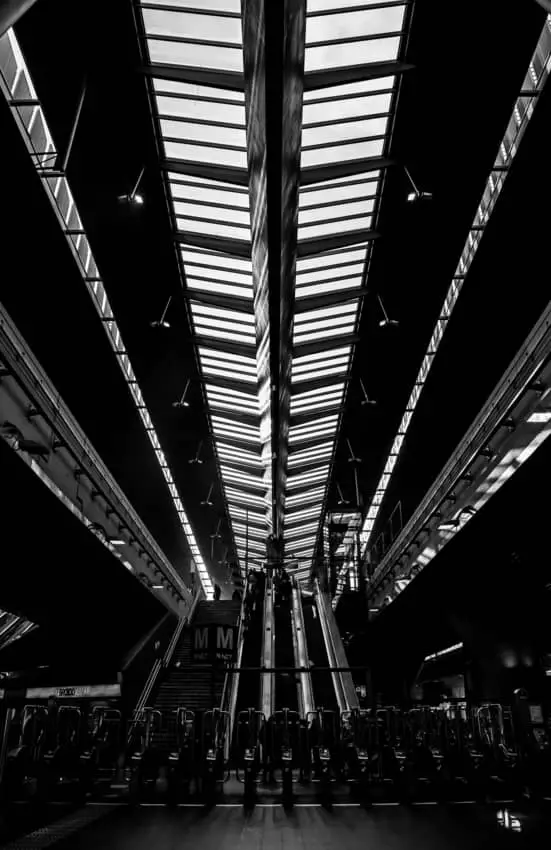Amsterdam metro is usually used for getting from the city center to the suburbs. It’s quick, relatively affordable and very convenient. However, what should one do in order to get to the outer districts at night? Is there any chance that the metro in Amsterdam operates 24 hours a day?
No, Amsterdam metro isn’t a 24-hour service. It operates from 6:00 am until midnight. There are some metro trains that end their run before midnight. On the other hand, some trains reach their points of destination later than midnight – around 1:00 am. Amsterdam metro trains usually run every 10 minutes.

There are of course many other options to travel through the city at night. In the article, you’ll find some more information about the metro network itself, as well as some recommendations on how to get home at the time the metro doesn’t operate.
Amsterdam Metro and Its Operating Hours
Amsterdam Metro is probably the most convenient way of reaching some key locations in the city (like the football stadium, Amsterdam WTC or the University of Amsterdam, as well as many Amsterdam rail stations) as it actually passes all main office districts and the most important businesses. It’s also the quickest way to get Waterlooplein or De Pijp from Central Station. The metro is a combination of light rail and rapid transit system. Not only does the system serve Amsterdam itself, but also some surrounding municipalities – Diemen, Amstelveen, and Ouder-Amstel. The whole network is owned by the City of Amsterdam. It’s operated by Gemeentelijk Vervoerbedrijf (GVB), a municipal public transport company. The very same company is the one operating free ferries, local buses, and trams. Amsterdam Metro is very fast and efficient. Recently, it has also become trendy – a couple of public artworks have become part of some of the stations. Among the others, a mosaic crocodile appeared on the wall at Rokin, Europaplein got some film noir-style photographs and there are icons representing birds at Noord.
The best way to check a timetable of the metro is 9292.nl – LINK
On this website, you can choose a mean of transport, for example, subway, tram, bus or train, time of departure or arrival and departure and arrival station
Some Facts About the Amsterdam Metro
A metro line in Amsterdam was an idea that dates back to the 60’. However, it took some time – the metro system began operations in 1977, as there were years of construction and several delays. At first, most of the lines led to residential areas outside the center. Obviously, a line that would pass under the city center was needed but it was extremely hard to process as the city was built on very swampy ground. An idea of building a metro that would be tunneled under the wooden posts (the posts Amsterdam is supported by) was considered to be a bad option, both from a technical and financial point of view. However, finally, the work was complete and the service could start being up and running. Four different types of train have been introduced since then. They are all still used now – the newest of them are the silver and red Alstom ‘Metropolis’ train stocks. What I can say for sure, they are enormous – they can carry almost 1,000 passengers at once.
And Now…
Currently, Amsterdam metro has five lines (M50, M51, M52, M53, and M54) that serve almost 60 stations (more than 30 of them are metro-only stations). The last one was added to the network in mid-2018. Most of the lines start at Amsterdam Central Station. The total length of the system is around 43 kilometers. The metro operates around 18-19 hours a day. It opens at 6:00 am and closes between midnight and 1:00 am. It’s estimated that a daily ridership is above 300,000 and approximately 14 million passengers use the service each year. Amsterdam metro transports passengers between South and North parts of the city (it’s a 10-km journey) in fifteen minutes, with stops at Noorderpark Station, Amsterdam Central, Rokin, Vijzelgracht, De Pijp, and Europaplein.

Amsterdam Metro Lines
There are five metro lines in total, all recognized by their name color and number. Four of them start from Amsterdam Central.
- Line 50 – Ring Line – operates between Isolatorweg and Gein, using a circular line. This is the only route that doesn’t cross the city center. It serves 20 stations. The line was built in 1997.
- Line 51 – Amstelveen Line – operates between Westwijk and Central Amsterdam. It serves 29 stations. The line was opened in 1990. The line stopped running south after the line 52 was opened – in March 2019. Instead it’s running north with the line M50.
- Line 52 – Noord/Zuid Line – has been operating between North and South areas (the line links the Northern suburbs with the South via the city center) since July, 2018. It serves 8 stations. The line 52 is the first metro line to run beneath the IJ river to the North.
- Line 53 – Gaasperplas Line – operates between Gaasperplas and Central Amsterdam. It serves 14 stations. The line was opened in 1977.
- Line 54 – Gein Line – operates between Gein and Central Amsterdam. It serves 15 stations. The line was opened in 1977.
The metro network consists of over one hundred trains. Some of the metro stations are shared with train lines (like Lelylaan, Zuid, Amstel).
Tickets for Amsterdam Metro
A single-use ticket for Amsterdam metro costs 2.90 Euro. A 1-hour ticket costs 3.20 Euro and a 1.5-hour ticket – 6.50 Euro. You can also buy a 1-to-7 – day ticket for 8 – 36.50 Euro, depending on how many days you stay in the city. Children pay 4 Euro for a 1-day ticket (children under the age of 4 travel for free). Tourists can also buy the Amsterdam City Card. Such card enables them to travel with lo limitations (all GVB routes) for 1, 2 or 3 days. The card is also valid as a ticket for some museums, canal trips and restaurants. The Amsterdam City Card costs 49 Euro/per 1 day, 59 Euro/2 days and 69 Euro/per 3 days.
You will find more details on ticket prices in the table below:
| Ticket | Prices (Euro) |
| a single use ticket | 2.90 |
| 1 hour | 3.20 |
| 1.5 hour | 6.50 |
| 1 day | 8.00 |
| 1 day – children | 4.00 |
| 7 days | 36.50 |
| 1 month | 91.00 (the reduced fare: 60.00) |
| 1 year | 910.00 (the reduced fare: 600.00) |
Depending on how long you’ll stay in Amsterdam, you can consider buying a temporary ticket or a long-term OV-chipcard. If you decide to buy the OV-card, you can use it throughout the entire Amsterdam public transport system. The card is a nationwide contactless smart card system – all metro stations have ticket barriers with free-standing card readers installed. Passengers are required to check-in and check-out f their journeys using the readers. Don’t forget that there aren’t any manned service desks anymore.
How to Travel at Night?
Even though Amsterdam metro doesn’t operate at night you can still get home on the Amsterdam night service. The GVB provides night transport with 12 bus routes. They all start their run from Amsterdam Central Station. Half of them end their run at Leidseplein and the rest at Rembrandtplein. To be honest, they have a stop at walking distance from everything. The night buses operate between 00:30 and 7:30 in the morning. Unlike most day-time lines, the night buses and trains only run once an hour. Sometimes they only stop at major stations so, in order to make sure you get home quickly and safely, check your routes online in advance. Also, traveling by a night train can take a little bit longer than usual because high-speed trains don’t run at night. Below you will find a table with some more information on the night routes:

| Line | Direction | Route |
| 351 | Slotervaart | Central Station – Leidseplein – Slotervaart – Central Station |
| 352 | Geuzenveld | Central Station – Leidseplein – Centrale Markthallen – Geuzenveld – Central Station |
| 353 | Osdorp De Aker | Central Station – Leidseplein – Osdorp De Aker – Central Station |
| 354 | Amstelveen | Central Station – Leidseplein – Amstelveen Galjoen – Centraal Station |
| 355 | Holendrecht | Central Station – Rembrandtplein – disco de Powerzone – Gaasperdam – Central Station |
| 356 | Bijlmermeer | Central Station – Leidseplein – Bijmermeer – Central Station |
| 357 | Gaasperplas | Central Station – Rembrandtplein – station Diemen – Diemen Zuid – Bijmermeer – Central Station |
| 358 | Schiphol airport | Central Station – Leidseplein – Schiphol Centrum |
| 359 | IJburg | Central Station – Rembrandtplein – Java Island – Indische buurt – Ijburg – Centraal Station |
| 361 | Nieuwendam | Central Station – Rembrandtplein – Camping Vliegenbos – Nieuwendam – Central Station |
| 362 | Banne Buiksloot | Central Station – Rembrandtplein – Camping Vliegenbos – Banne Buiksloot – Central Station |
| 363 | Molenwijk | Central Station – Rembrandtplein – Molenwijk – Central Station |
Night Tickets
You can buy tickets for night buses at all ticket vending machines and at a GVB Service Point, as well as from the driver directly. A 1.5-hour ticket costs 4.50 Euro. Such ticket enables you to travel with no limits by all GVB buses which means the ticket includes any transfers you may have within 90 minutes. You can also purchase a different ticket option: a 12-journey ticket for 25 Euro or a 24, 48 or 72-hour night bus travel pass. You will find more details on tickets on the GVB website.
Summary
In my opinion, Amsterdam metro is particularly useful when you want to get to the outskirts of the city. It radiates from the Central Station to the outlying districts. There’s no better option to reach some areas that aren’t very close to the city center. However, if you need to get from point A to point B, both somewhere in the city center, I actually recommend that you travel by tram or by bus.